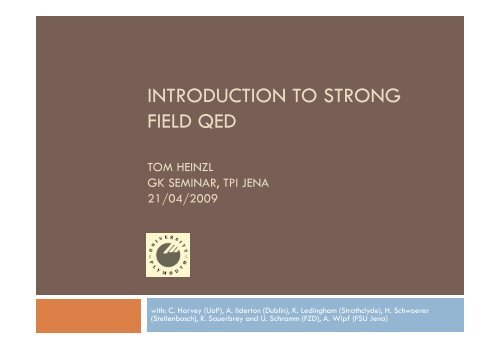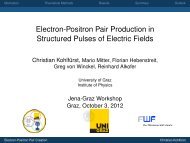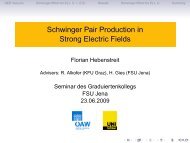INTRODUCTION TO STRONG FIELD QED
INTRODUCTION TO STRONG FIELD QED
INTRODUCTION TO STRONG FIELD QED
You also want an ePaper? Increase the reach of your titles
YUMPU automatically turns print PDFs into web optimized ePapers that Google loves.
<strong>INTRODUCTION</strong> <strong>TO</strong> <strong>STRONG</strong><br />
<strong>FIELD</strong> <strong>QED</strong><br />
<strong>TO</strong>M HEINZL<br />
GK SEMINAR, TPI JENA<br />
21/04/2009<br />
with: C. Harvey (UoP), A. Ilderton (Dublin), K. Ledingham (Strathclyde), H. Schwoerer<br />
(Stellenbosch), R. Sauerbrey and U. Schramm (FZD), A. Wipf (FSU Jena)
Outline<br />
1. Introduction<br />
2. Strong Field Electrodynamics<br />
Application I: Relativistic charges in laser fields<br />
3. Quantum Electrodynamics<br />
4. Strong Field <strong>QED</strong><br />
Application II: vacuum polarisation effects<br />
Application III: nonlinear Compton scattering [tomorrow]<br />
5. Summary and Conclusions
1. Introduction
Explaining the title<br />
“<strong>QED</strong>” = quantum electrodynamics<br />
Quantum gauge field theory<br />
describes interactions of “light” and “matter”<br />
“light”: photons<br />
“matter”: charged elementary particles<br />
Leptons: electron, muon, tau<br />
Quarks: up, down, strange, … (bound into hadrons)<br />
NB1: mainly discuss electrons<br />
NB2: “matter” includes anti-matter (positrons etc.)
Explaining the title cont d<br />
“Strong Field”<br />
Throughout this lecture: strong field = laser<br />
Typical magnitudes assumed are<br />
Power<br />
Intensity<br />
Electric field<br />
Magnetic field
Strong field parameter<br />
‘dimensionless laser amplitude’<br />
(purely classical) ratio (no ):<br />
NB: implies relativistic quiver motion of<br />
electrons in laser beam
2. Strong Field Electrodynamics<br />
Relativistic charges in electromagnetic fields
Motivation<br />
Direct laser acceleration (DLA) in vacuum –<br />
Usual RF cavities break down at ‘critical’ electric field<br />
of about 10 8 V/m<br />
Can one use a laser to accelerate particles?<br />
No – in a perfect plane wave (Lawson-Woodward theorem)<br />
Yes – in ‘realistic’ laser fields<br />
experiments at proof-of-principle stage<br />
30 → 30.03 MeV (Plettner, PRL 95, 134801 (2005))<br />
40 → 43.7 MeV (Campbell et al., IEEE TPS 28, 1094 (2000))
Covariant equation of motion<br />
Charge e, mass m in field<br />
Equation of motion:<br />
where dot denotes derivative w.r.t. proper time<br />
R.h.s.: relativistic Lorentz force<br />
Task: find trajectory<br />
NB: as EoM in general nonlinear!
Simplification I: constant fields<br />
EoM becomes linear for constant fields,<br />
Write in matrix form<br />
where<br />
First integral :<br />
Second integral: 4 cases – depending on invariants
Constant fields: 4 cases (Taub 1948)<br />
Table:<br />
Name<br />
Loxodromic<br />
Elliptic<br />
Hyperbolic<br />
Parabolic<br />
Field configuration<br />
(special frame)<br />
Invariant characterisation<br />
(frame independent)<br />
NB: parabolic = crossed or null fields,
4 cases: illustration<br />
Hyperbolic<br />
Loxodromic<br />
(C. Harvey)<br />
Elliptic<br />
Parabolic<br />
NB: net acceleration<br />
Hyperbolic: basic<br />
principle of standard<br />
accelerator<br />
Loxodromic:<br />
accelerator with<br />
magnetic focussing<br />
Parabolic: laser<br />
subcycle acceleration<br />
Elliptic: no<br />
acceleration
Simplification II: plane waves<br />
Covariant description of plane wave field<br />
Light-like wave 4-vector , →<br />
dispersion for massless particles<br />
Ingredients<br />
Invariant phase<br />
Field strength:<br />
Transversality:<br />
Null field:<br />
Conservation law:<br />
makes EoM linear, hence integrable
Illustration I: linear polarisation<br />
Trajectory of charge in average rest frame<br />
(mean drift velocity subtracted)<br />
Lissajous 2:1
Illustration II: Circular polarisation<br />
Trajectory of charge in average rest frame<br />
(mean drift velocity subtracted)
DLA: Conclusion<br />
Motion in periodic plane wave fields ( )<br />
Periodic and bounded<br />
Hence no net acceleration (Lawson-Woodward<br />
theorem)<br />
Loophole: give up periodicity, e.g. crossed fields<br />
( )<br />
Motion aperiodic and unbounded<br />
Net (‘subcycle’) acceleration
DLA: Outlook<br />
Work in progress<br />
realistic laser fields<br />
include radiation loss<br />
numerical scheme<br />
Application<br />
Plug calculated orbits into Larmor formula<br />
Determine classical radiation spectrum<br />
(Sarachik/Schappert 1970, Esarey et al. 1996, ...)
3. <strong>QED</strong><br />
3.1 Introduction
Switching on h-bar<br />
Recall dimensionless laser amplitude: energy gain<br />
across laser wavelength in units of<br />
for relativistic electrons<br />
Replace laser by Compton wavelength<br />
and demand energy gain across to be
Critical electric field<br />
This yields ‘critical’ electric field (Sauter 1931)<br />
In this field a change in energy occurs within<br />
microscopic length scale<br />
Hence, it becomes possible to create electron<br />
positron pairs from vacuum<br />
Presence of and c: relativity ∪ quantum theory<br />
Need relativistic quantum field theory: <strong>QED</strong>!
<strong>QED</strong> Lagrangian<br />
Compact version:<br />
Covariant derivative<br />
guarantees gauge invariance under<br />
→ photon massless<br />
determines interaction
<strong>QED</strong>: basic interaction<br />
Rewrite interaction term<br />
So, coupling of gauge field to Dirac current<br />
Pictorially: Feynman diagram of ‘<strong>QED</strong> vertex’<br />
Dirac field<br />
Photon field<br />
coupling strength<br />
Dirac field
Feynman diagrams<br />
Tree level, e.g.<br />
Loops, e.g.<br />
Compton scattering<br />
O( )<br />
Typically finite<br />
[tomorrow’s talk]<br />
Vacuum polarisation<br />
O( )<br />
Typically infinite<br />
If so, renormalise
Photon-photon scattering<br />
Loop effects imply photon-photon coupling mediated<br />
by virtual Dirac particles<br />
Feynman diagram (finite due to gauge invariance!)<br />
(Low energy: Euler, Heisenberg,<br />
Kockel 1935, 1936<br />
High energy: Akhiezer 1937)<br />
Induced nonlinearity: effective terms in<br />
Lagrangian, in EoM
Photon-photon scattering cont d<br />
Low energy analysis:<br />
At low energy: virtual loop not resolved<br />
Obtain effective theory with effective vertices<br />
Heisenberg-Euler effective Lagrangian: nonlinear<br />
quantum correction to Maxwell theory
Heisenberg-Euler<br />
Discussion:<br />
<br />
<br />
<br />
from 4 <strong>QED</strong> vertices<br />
from dimensional analysis (Lagrangian has mass<br />
dimension 4 in d=4)<br />
and from gauge invariance<br />
recall: ,<br />
Coefficients and from detailed calculation
Photon-photon scattering cont d<br />
Low-energy cross section<br />
Invariant amplitude: each gradient from etc.<br />
produces frequency factor<br />
2<br />
X-section (optical regime):<br />
NB: not measured yet (→ bounds)<br />
suggestion for Astra Gemini: (Marklund et al., 2006)
Loops vs. trees: optical theorem<br />
Optical theorem (Kramers-Kronig):<br />
“the imaginary part of the forward scattering<br />
amplitude is proportional to the total cross section”<br />
Example: photon-photon scattering<br />
Scattering loop<br />
Pair production cross<br />
section → absorption
4. Strong Field <strong>QED</strong><br />
Vacuum polarisation effects
Strong field <strong>QED</strong><br />
Recall <strong>QED</strong> interaction<br />
Assume presence of external strong laser field<br />
Get additional interaction (no )<br />
Include into free Lagrangian<br />
Main effect: replace free Dirac electrons by Volkov<br />
electrons (electrons ‘dressed’ by e.m. wave)<br />
Pictorially: ‘dressed’ (Volkov) electron line
Field decomposition<br />
Two types of photons<br />
Weak ‘probe field’ : perturbative<br />
Strong background field : nonperturbative<br />
Effective Lagrangian = expansion in<br />
Goal: determine ‘coefficients’ exactly<br />
Only possible for special backgrounds
Strong field vacuum polarisation<br />
Consider leading (bilinear) order<br />
coefficient = dressed vacuum polarisation loop:<br />
Polarisation<br />
tensor<br />
<strong>QED</strong><br />
LO SF<strong>QED</strong>
Polarisation tensor: crossed fields<br />
Simplest case: crossed fields (constant null fields)<br />
Consequence: laser background has<br />
Two remaining invariants:<br />
Probe 4-momentum squared:<br />
where is index of refraction due to laser BG<br />
Energy density seen by probe:<br />
BG energy-momentum tensor
crossed fields cont d<br />
Determine relevant eigenvalues of<br />
<br />
: two nontrivial dispersion relations<br />
NB: can be viewed as stemming from effective<br />
metrics<br />
Result:<br />
‘vacuum’ birefringence
Indices of refraction<br />
Formula (Toll 1952)<br />
Two small parameters<br />
dimensionless field strength (recall: )<br />
dimensionless probe frequency<br />
Note dependence on product
Experiment: measure ellipticity<br />
Phase retardation of e +
Analysis<br />
ellipticity (squared)<br />
Power law suppressed…<br />
Optimal scenario @ ELI<br />
large intensity:<br />
large probe frequency (X-ray, ):<br />
Still experimental challenge!
New frontiers: increase parameters<br />
Theory: for large , refractive indices develop<br />
imaginary part, (Toll 1952)<br />
Reason: pair creation (→ optical theorem)<br />
Q: can one get there?<br />
Large : currently science fiction<br />
Large : use Compton backscattering!
Parameter range<br />
<br />
: Compton backscattering off high-energy<br />
(from linac or wake field accelerator)<br />
SLAC<br />
10 6 Vulcan<br />
10 3<br />
ELI<br />
Backscattered<br />
(5 GeV )<br />
1<br />
1 PW<br />
10 PW<br />
all-optical<br />
10 -6 10 -4 10 -2 1
Large-ν birefringence I<br />
<br />
for : 3 GeV @ ELI, 10 GeV @ Vulcan10PW<br />
Toll 1952<br />
Shore 2007<br />
NB: SLAC E-144 had<br />
(K. Langfeld)
Large-ν birefringence II<br />
For , : find anomalous dispersion and<br />
Possibly, alternative signal for PP<br />
Subtle interplay between probe energy (ν) and laser<br />
intensity (ǫ 2 )<br />
Open questions:<br />
Polarimetry for high-energy γ’s ?<br />
Experimental signatures ?
5. Conclusion
Strong laser fields<br />
Direct laser acceleration in vacuum<br />
Proof of principle<br />
More advanced: plasma wake field acceleration<br />
Strong field <strong>QED</strong><br />
Absorptive: Pair creation – at which field strength?<br />
Dispersive: vacuum birefringence<br />
Scattering processes: no thresholds<br />
Gamma-gamma scattering<br />
High-intensity Compton




